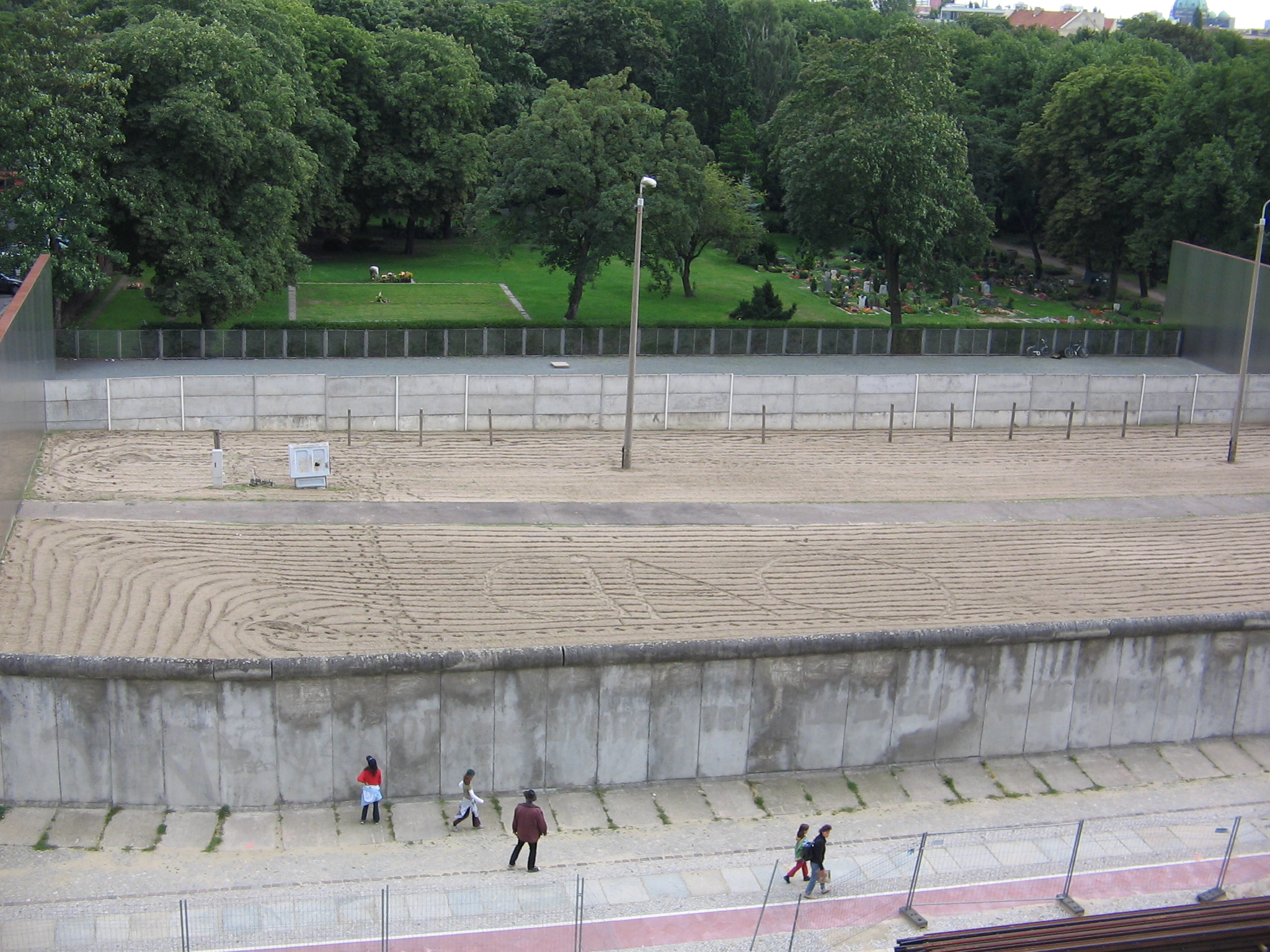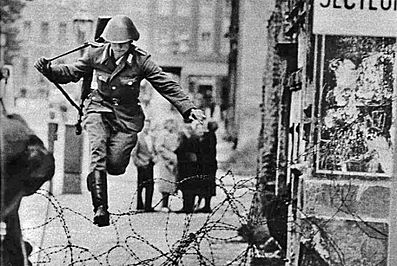The Berlin Wall and Memories of a Frightened Teenager..
 These past days we've been reminded that the fall of the Berlin Wall (the picture shows the Wall with the infamous "Todesstreifen" ["death strip"]) occurred 25 years ago, with the official celebration on November 9, 2014.
These past days we've been reminded that the fall of the Berlin Wall (the picture shows the Wall with the infamous "Todesstreifen" ["death strip"]) occurred 25 years ago, with the official celebration on November 9, 2014.
For many Germans the Berlin Wall also involves personal memories either directly or through relatives or friends.
When the Wall was built in 1961, it further divided a city which, since 1945, had been living with the division into four sectors: US, UK, French, and Soviet.
The “brain” drain through the open border in Berlin caused the East German government (obviously with Russian concurrence and some say, encouragement) to opt for a wall: Too many East Germans (estimated at about 3.5 million) were voting with their feet and sought refuge and freedom in the west sectors before being flown out to West-German.
“Ich bin ein Berliner”
The building of the Wall was also seen by many observers at the time as a test of the new American President, John F. Kennedy. Historians seem to be divided over whether and how much the President and the intelligence community knew about the plans for a wall, or if there was even a tacit American acquiescence for its construction.
President Kennedy visited Berlin in 1963 and his speech - with its now famous words “Ich bin ein Berliner” - was credited for giving West Berliners a very needed moral boost. I remember this speech very well as a teenager, and while we may have chuckled a bit (see also our blog post Quick German: “Ich bin ein Berliner”), we certainly understood the significance of the speech.
Memories of Frightened Teenager
West-Berliners were not allowed to visit East Berlin initially. These restrictions were later eased for holidays and other "hardship" circumstances. (And East Germans could only travel to West-Berlin and West-Germany with special authorizations and under tight control in later years).
On the other hand, West Germans could usually visit East Germany and East Berlin after obtaining a visa. A trip to Berlin had become a tradition for many senior classes in West-German High Schools and so, in 1965, I found myself on a bus to East Berlin going through the Wall at Check Point Charlie.
While I do not recall being checked as we entered East Berlin, I certainly remember being stopped on the way out. We all had to get out of the bus and present our passports to an East German border guard.
He looked at my passport, then asked me to step into an adjacent room. A grim-looking officer waved the passport in front of my face and said that it was not valid. By that time (and while our teacher and my class mates looked on helplessly through a windowed door) all I could think of saying was “But this is a new passport, I just got it before the trip.” The officer looked me up and down, looked at the picture again and then, reluctantly satisfied and after what seemed like an eternity, finally said: “Then you'd better sign it.”
I still remember now that my legs were shaking when I joined my class again. What seemed like an insignificant and easily corrected oversight was a serious issue in 1965 in East-Berlin (and, with heightened security concerns, maybe it is now again everywhere).
Many attempts to escape from East-Berlin were made, through tunnels, through sewers, in cars, by swimming, etc. Over 100 people were killed during such attempts, when the East German Police received shoot-to-kill orders shortly after the Wall was built.
And while I, as a West-German, should have had nothing to fear, the climate of intimidation, cold-war press reports, etc. had affected me as well and frightened me.
“Mr. Gorbachev, tear down this wall!”
After President Reagan had made another famous speech at the Brandenburg Gate in 1987, it took a little more than 2 years for the Eastern Block to disintegrate. Historians and politicians may still debate whether President Reagan's or Bush's policies were more responsible for the fall of the Wall and the dissolution of the Soviet Union and the countries it controlled or whether such policies just accelerated an inevitable system failure.
Hungary and Czechoslovakia had already started to allow East Germans to leave through their countries in mid1989; protests in East Germany culminated in a demonstration of over half a million people on the Alexanderplatz in Berlin on November 4, 1989.
 And then events further accelerated. By November 9, the new East-German government saw the handwriting on the wall (no pun intended) and amidst confusion of directives and orders to the border guards by government officials the borders opened up.
And then events further accelerated. By November 9, the new East-German government saw the handwriting on the wall (no pun intended) and amidst confusion of directives and orders to the border guards by government officials the borders opened up.
(This 1961 picture actually shows the iconic photo of Conrad Schumann, an East German soldier of the People's Army escaping, just as the Wall was being built. As described in this 2009 Wordpress post, his story had a tragic ending.)
The official dismantling of the much-hated Wall only began in mid 1990. On October 3, 1990 the East German state was dissolved and joined the West German state in becoming the reunited Germany.
Today, Berlin is again the capital of Germany and, with a population of about 3.5 million, its largest city. It has also regained its status as, arguably, one of the world's top cities for science, culture, media, and politics.
